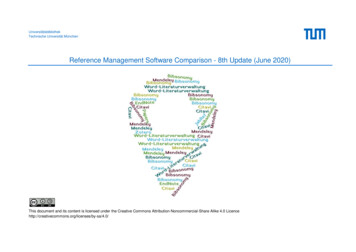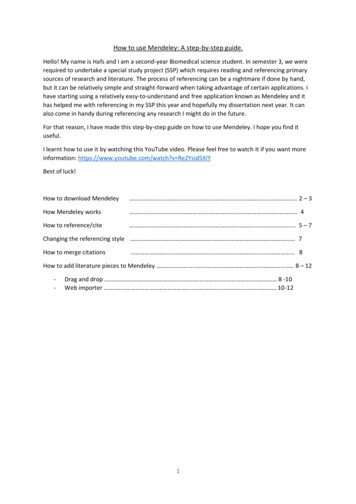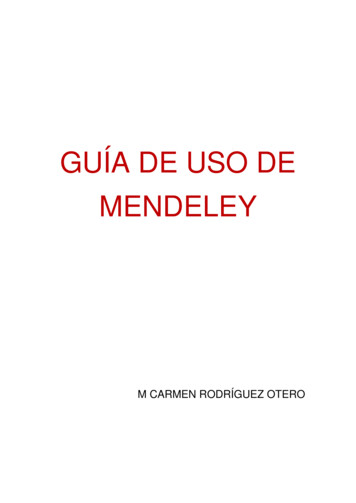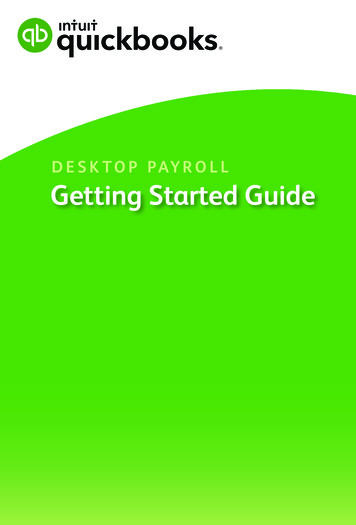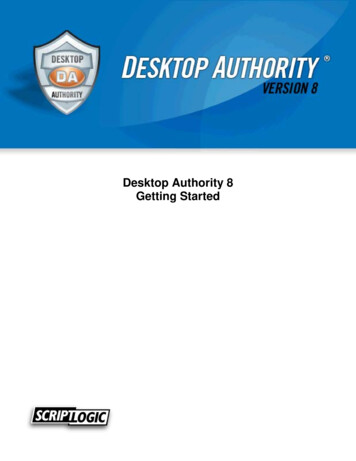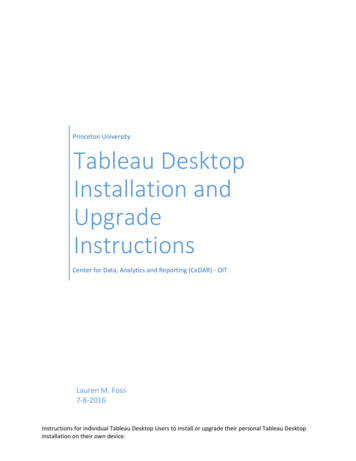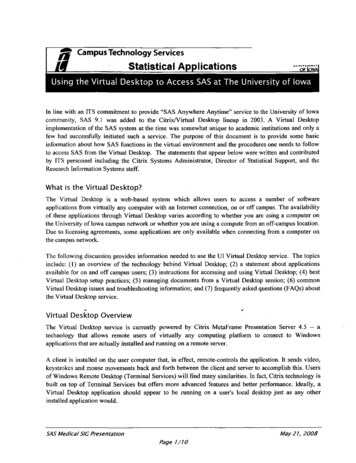
Transcription
Getting startedwith MendeleyCreated by: MendeleyLast updated: October 2010www.mendeley.com1.Creating your library . 2Add PDFs to Mendeley . 2Import/export EndNote , BibTeX and RIS libraries . 2Document details lookup (CrossRef, PubMed, and ArXiv) . 3Google Scholar Search . 3One-click Web Importer . 4Watch folders to automatically add PDFs to Mendeley Desktop. 5Synchronize PDFs with your Mendeley Web account . 52.Managing your documents and references . 6Merge duplicate author names, tags, or publications . 6Documents can be marked read/unread . 6Search as you type . 7Annotate PDFs . 7Multiple level undo in document details . 8Tag and edit multiple documents at once . 8File Organizer . 93.Citing references. 10Word and OpenOffice plug-in . 10Cite in Google documents (and other editors) . 11Cite using BibTeX . 124.Sharing Documents and References . 13How to Create a Group . 13Adding members and documents . 14Using Groups . 155.Support . 16
1. Creating your libraryAdd PDFs to MendeleyYou can add PDFs to Mendeley by clickingthe Add Document button on the far left ofthe toolbar. Alternatively, you can drag anddrop PDFs into the content pane. Mendeleywill then attempt to detect the documentdetails (bibliographic data).Any documents whose details Mendeley isuncertain about will be added to the NeedsReview section for manual verification. Youmay use Mendeley’s Document detailslookup (CrossRef, PubMed, and ArXiv) orGoogle Scholar Search to complete missingdocument details (see below).Drag & drop PDFs here toadd them to your library.Import/export EndNote , BibTeX and RIS librariesSwitching from other reference management software such as EndNote to Mendeley is simple. AsEndNote uses their own proprietary file extension (.enl) you will need to export your library as .xmlfile (the more open common standard) in order to migrate to Mendeley:In EndNote :1. Select FileExport2. Choose “XML” type and “RIS” as output style3. Give your library a name and save it on your PCThen in Mendeley:1. Select FileAdd Files2. Choose the XML file that you have previously exported from EndNote and click on “Open”3. Your EndNote library will appear in Mendeley DesktopTo import BibTeX and RIS XML alongside PDFs choose:FileAdd FilesLikewise your data can easily be exported from Mendeley:1. Select the documents you would like to export and go to FileCtrl E or Cmd E on MacOS.Export or press2. You will then be given the option to save your files in the most common formats - .xml, .ris,and BibTeX files.2
Document details lookup (CrossRef, PubMed, and ArXiv)You can also lookup document details from CrossRef (DOI),PubMed (PMID), and ArXiv. Just fill in the document ID in therespective field and click the magnifying glass icon next to it toget the details for those documents. These fields are located inthe Details tab.Google Scholar SearchYou can lookup document details with Google Scholar in Mendeley:1. Input the correct document title2. Click searchMendeley will try to complete the missing data from Google Scholar. (Note: The lookup works onlyfor imported PDF files and not for manually added entries.)213
One-click Web ImporterYou can import references with a single click from the services listed below. To install the WebImporter and to find out how to use it, just select:ToolsInstall Web Importer ACM Portal Google BookSearch PLoS ACS Publications Google Scholar PNAS AIP Scitation IACR ePrints PubMed Amazon IEEE Xplore RePEc APS Informaworld SAGE APA PsycNET IngentaConnect ScienceDirect arXiv INIST/CNRSI ScienceMag BioMedCentral Institute of Physics Scirus BioOne ISI Web of Knowledge Spires CiteseerX JSTOR SpringerLink CiteULike Lancet Journals SSRN Copac MyOpenArchive Wikipedia DBLP NASA ADS Wiley InterScience EBSCO Nature GBV OpticsInfoBase WorldCatZetoc and growing.4
Watch folders to automatically add PDFs to Mendeley DesktopWhen you place a document in a watched folder, it willbe automatically added to Mendeley so you canannotate, cite, and browse its references instantly.Adding files to Mendeley using watched folders makes iteasier to add multiple papers in one go and keep themwhere you want on your computer.Synchronize PDFs with your Mendeley Web account4123If you want to have access to your PDFs from anywhere, activate the file synchronizationfeature. By enabling this feature you are able to access your PDF files in your Mendeley Weblibrary.1. Make sure that “All Documents” in the “My Library” pane is selected2. Select “Edit Settings”3. Adjust the settings to your needs.4. Synchronize your library5
5. Login to your Mendeley Web account and see the result in your library2. Managing your documents and referencesMerge duplicate author names, tags, or publicationsIn the filter by authors/tags/publications pane, click a name you recognize has beenduplicated or is incorrect, and drag & drop it onto the correct one to rename it.E.g. if you have two documents tagged “How to” and “how-to”, dragging the latter one ontothe former will rename the incorrect entry.Documents can be marked read/unreadKeep track of your unread papers. Whenyou add documents to Mendeley, they aremarked unread by a small green dot. If youopen them within the Mendeley PDF viewerthey will be marked read. Or simply click onthe green dot to toggle read/unread.FavoritesYou can mark your favorite documents (ordocuments you keep want to track of) withthe star icon. Simply click to star, and clickagain to un-star. All favorite documents willappear in the Favorites Folder, so you canrefer back to them with one click.6
Search as you typeSmart search in documents highlights the search term as you type, so you can find whatyou're looking for quickly. Just type into the search bar and watch Mendeley find matchingterms in the document.Annotate PDFsYou can add highlights and notes to documentswithin Mendeley Desktop.1. Open a PDF in Mendeley's PDF viewer bydouble clicking on it in the central pane,2. Add highlights and notes by clicking on theHighlight Text or Add Note buttons on themenu.You can share these annotations with your co-workers. To do so1. Open a PDF that is part of a Group (see below),2. Make your annotations,3. Sync these annotations to Mendeley Web by going back to “My Library” and clicking on“Sync Library”.7
Note: These annotations are not stored in the actual PDF-file, but rather in your Mendeleyaccount. To create a new PDF file that contains all annotations, you can export the PDF withall its annotations by choosing: File Export with Annotations from within the MendeleyPDF viewer.Multiple level undo in document detailsYou can undo recent changes to your document details or annotations by clicking Undo inthe usual place. Select the following option in the drop down menu:EditUndoor Ctrl Z (Cmd Z for Mac)Tag and edit multiple documents at onceWhen you want to tag or add details for more than one document in one go:3. Select the documents you wantto edit at once by pressing Ctrl left clicking the documents youwant to select4. Noticethebatchconfirmation message2editing15. Input your dataThe data can be tags, notes, or otherdocument details such as thepublication name.3E.g., in this example the entered tagswill be applied to all selecteddocuments.8
File OrganizerMendeley's file organizer can automatically rename your PDFs and file them in a clear folderstructure, making it easier to find your files outside of Mendeley. You can find it here:ToolsOptions Fileor for Mac choose: MendeleyPreferencesIn the tab, select:1. Organize my files: to make acopy of all documents addedto Mendeley within one folder2. Sort files into subfolders: tocreate a folder structurebased on selected documentdetails3. Rename document files: torename the often nondescriptive names of yourPDFs to file names that aremore meaningful, includingthe author, journal, year, andtitleOrganizer tab1239File Organizer tab
3. Citing referencesWord and OpenOffice plug-inOnce you have your documents in Mendeley, you can cite and reference them within Wordand OpenOffice with ease. The Mendeley Word & OpenOffice plug-ins integrate Mendeleyinto these word processors. Once installed you will have tool bar buttons that will allow you tocite a document, generate a bibliography, or manually edit any entry, saving you time andeffort when you write.When you are creating a paper and you want to cite a document from your Mendeley Library:131. Click Insert Citation in the Mendeley tool bar within Word2. Select the document in Mendeley Desktop, and click Send Citation to Word. You canalso cite multiple documents. Just hold the Ctrl key (or the Cmd key on Mac) and left clickthe documents you want to cite.3. Select the citation style in the drop down menu in your word processor210
This will now send the citation to Word:You can now generate a bibliography by clicking “Insert Bibliography”:Cite in Google documents (and other editors)You can also add citations in other text editors, such as Google Docs. Just select the paperyou want to cite in Mendeley Desktop and click:EditCopy CitationThen Paste it into the document you are composing. Alternatively, you can drag & drop thepaper from the Mendeley Desktop window to the document, and a reference in the currentselected citation style will be added there.11
Cite using BibTeXYou can also cite and createbibliographies in LaTeX documents.Mendeley Desktop creates aBibTeX file for your entire library, foreach group or per document. TheBibTeX file(s) are updated eachtime you make a change to yourpersonal library in MendeleyDesktop.The citation keys are automaticallygeneratedintheformat[AuthorYear]. You may edit citationkeys manually by enabling the“Citation Key” field under Options(Document Details tab). Then you can edit citation keys under the Document Details tab inyour library.You may enable BibTeX support here:ToolsOptionsBibtex Tab12
4. Sharing Documents and ReferencesHow to Create a GroupGroups are a simple way for you to collaborate with yourcolleagues and share a collection of documents. Any memberof a group may upload documents to it. You can create agroup by clicking on “Create Group” in the left hand pane.Once you have clicked “Create Group”, a dialog asking you to enter details of your group willappear.1. Group name allows you to specify a name for your group.2. Group description allows you to enter details about the group.3. The section Privacy settings allows you to choose the type of group you want to create(see below).4. To add Tags, or to assign a research discipline to your group (by default, this is yourown discipline) click on Add additional info.13
5. Click on Create Group to finish.Note: You can review these settings later by clicking on “Edit settings”.There are three types of groups:1. Private Groups – These are invite-only groups whose content will only be visible tomembers of the group. These groups are great for private research projects.2. Public Invite-only Groups – These are groups which are visible to anyone, but onlymembers can contribute to them.These groups are great for public reading lists orcurating your lab’s research output.3. Public Open Groups – These are groups anyone may join and contribute to. They aredesigned for open discussion groups around any subject.Adding members and documentsOnce you have created your group, you can add members and documents to it.1. To Invite Members to the group go to the Members tab.2. You can either add people that are already your contacts on Mendeley by clicking on“Add”, or you can invite people to join you on Mendeley by clicking on “Invite”.3. You can view the documents of a group by going to the Documents tab. To AddDocuments, go to the group and click on “Add documents” in the top bar. Alternatively,you can simply drag and drop documents to the group (either from your Mendeleyfolders, or from anywhere else on your computer).14
4. To download the PDFs that other group members attach to a group, go to Edit Settingsand tick “Download attached files to group”.Note: the attached PDF files can only be shared in Private Groups, not in Public Groups.5. To upload your group with all its settings to Mendeley Web, hit the Sync Library button.Using GroupsThe overview tab shows a summary of what has happened in your Group. You can seeupdates on who has joined, who said what, and which papers have been added by whom.You can also post status updates by entering your update into the box at the top of theoverview section.Additionally, you can post comments and discuss your research. Just click on “comment”and start a discussion on any given topic.With Mendeley Groups you can collaborate, discuss, and discover new research togetherwith your colleagues. Create your own Mendeley Group today!15
5. SupportIf you would like to request a feature orreport a bug in Mendeley, please visithttp://feedback.mendeley.comor send an e-mail tosupport@mendeley.com16
1. Open a PDF in Mendeley's PDF viewer by double clicking on it in the central pane, 2. Add highlights and notes by clicking on the Highlight Text or Add Note buttons on the menu. You can share these annotations with your co-workers. To do so 1. Open a PDF that is part of a Group (see below), 2. Make your annotations, 3.File Size: 1MB

